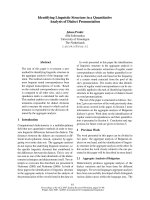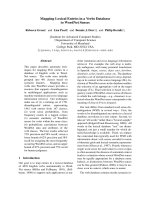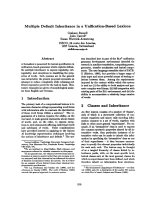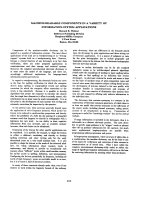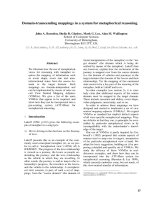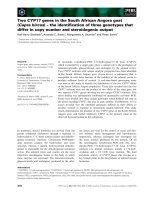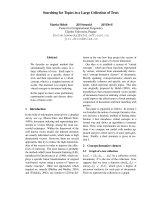báo cáo khoa học: "Two successful pregnancies in a woman with chronic myeloid leukemia exposed to nilotinib during the first trimester of her second pregnancy: case study" potx
Bạn đang xem bản rút gọn của tài liệu. Xem và tải ngay bản đầy đủ của tài liệu tại đây (201.4 KB, 4 trang )
BioMed Central
Page 1 of 4
(page number not for citation purposes)
Journal of Hematology & Oncology
Open Access
Case study
Two successful pregnancies in a woman with chronic myeloid
leukemia exposed to nilotinib during the first trimester of her
second pregnancy: case study
Monika Conchon*
1
, Sabri S Sanabani
2
, Israel Bendit
1
,
Fernanda Maria Santos
2
, Mariana Serpa
1
and Pedro Enrique Dorliac-Llacer
1
Address:
1
Department of Hematology, Faculty of Medicine, University of São Paulo, São Paulo, Brazil and
2
Fundação Pro-Sangue, Hemocentro de
São Paulo, Brazil
Email: Monika Conchon* - ; Sabri S Sanabani - ; Israel Bendit - ;
Fernanda Maria Santos - ; Mariana Serpa - ; Pedro Enrique Dorliac-
Llacer -
* Corresponding author
Abstract
The occurrence of chronic myeloid leukemia in pregnancy is rare and its management poses a
clinical challenge for physicians treating these patients. We report a 30-year-old woman with
chronic myeloid leukemia who became pregnant twice successfully. Philadelphia-positive CML in its
chronic phase was diagnosed at 16 weeks of her first gestation. At that time, she received no
treatment throughout her pregnancy. At 38 weeks of gestation, a normal infant was delivered by
cesarean section. At six weeks postpartum, the patient underwent imatinib mesylate therapy but
she could not tolerate the treatment. The treatment was then changed to nilotinib at 400 mg orally
b.i.d. Two years later, she became pregnant again while she was on nilotinib 200 mg b.i.d. The
unplanned pregnancy was identified during her 7.4 weeks of gestation. Because the patient elected
to continue her pregnancy, nilotinib was stopped immediately, and no further treatment was given
until delivery. Neither obstetrical complications nor structural malformations in neonates in both
pregnancies were observed. Both babies' growth and development have been normal. Although this
experience is limited to a single patient, the success of this patient demonstrates that the
management of chronic myeloid leukemia in pregnant women may be individualized based on the
relative risks and benefits of the patient and fetus.
Introduction
Chronic myeloid leukemia (CML) is a clonal myeloprolif-
erative disorder that occurs as a result of a reciprocal trans-
location between chromosome 22 and chromosome 9, or
the Philadelphia translocation [1]. This translocation cre-
ates a fusion gene-breakpoint cluster region bcr-abl proto-
oncogene, which encodes an oncoprotein that has consti-
tutively active abl tyrosine kinase (TK) activity. The intro-
duction of the TK inhibitor (TKI) imatinib in 1998
indisputably advanced the clinical management of cancer.
Imatinib has demonstrated its efficacy by increasing over-
all survival and substantially improving the life expect-
ancy and quality of life of patients with CML. As a result,
patients who are of childbearing age and are currently
being treated with imatinib now find themselves contem-
plating reproductive opportunities that would not have
Published: 6 October 2009
Journal of Hematology & Oncology 2009, 2:42 doi:10.1186/1756-8722-2-42
Received: 17 September 2009
Accepted: 6 October 2009
This article is available from: />© 2009 Conchon et al; licensee BioMed Central Ltd.
This is an Open Access article distributed under the terms of the Creative Commons Attribution License ( />),
which permits unrestricted use, distribution, and reproduction in any medium, provided the original work is properly cited.
Journal of Hematology & Oncology 2009, 2:42 />Page 2 of 4
(page number not for citation purposes)
otherwise been possible. However, the occurrence of CML
during pregnancy poses a unique clinical challenge for
physicians treating these patients and requires balancing
concerns between maternal survival and fetal health in
both the short- and long-term. Because imatinib was tera-
togenic in rats, it was strongly advised that effective con-
traception be used during therapy to prevent pregnancy
[2]. The inability of patients to tolerate treatment and the
emergence of bcr-abl mutations that reduced the binding
affinity of imatinib prompted pharmaceutical research
that led to the discovery of similarly effective, targeted,
second generation TKIs such as nilotinib (Novartis) and
dasatinib (Bristol-Myers Squibb). There is still insufficient
efficacy and safety data on these newer medications to
warrant their safety in pregnant women with CML. In this
study, we are reporting the outcome of a patient with CML
who became pregnant twice successfully. The patient was
only observed without active intervention for the duration
of her first pregnancy while received nilotinib at the time
of her second conception.
Case description
In February 2006, during a routine antenatal examina-
tion, a 30-year-old woman at 16 weeks of gestation was
diagnosed with Philadelphia-positive CML in its chronic
phase. She was normal upon physical examination with-
out any noteworthy clinical symptoms. Laboratory stud-
ies showed hemoglobin 10.7 g/dL, platelets 101 × 10
9
L
and white cell count 23,4 × 10
9
L with a differential reveal-
ing 7% myelocytes, 2% promyelocytes, 15% metamyelo-
cytes, 28% band cells, 39% neutrophils, 3% eosinophils,
0% basophils, 4% lymphocytes and 2% monocytes. The
diagnosis of CML was confirmed based on bcr-abl mRNA
transcript detection and conventional chromosome band-
ing, which revealed a 46,XY, t(9;22) karyotype. The
patient was treated with 3 million IU × 5 of interferon
alfa-2a every week throughout her pregnancy. At 38 weeks
of gestation, a normal infant was delivered by cesarean
section. In March 2007, she started imatinib 400 mg daily
and continued oral contraceptives. In May 2007, while in
complete hematological remission (HR), she developed
grade 3 hepatotoxicity (aspartate aminotransferase (340
U/l: normal range (N) <40 U/l), alanine aminotransferase
(640 U/l: N <40 U/l), gamma glutamyltransferase (423 U/
l: N <80 U/l), total bilirubin (0.55 mg/dl) and alkaline
phosphatase were normal) according to the NCI common
toxicity criteria for adverse events (CTCAE v3.0). A sero-
logic investigation for hepatitis A, B and C was negative.
Because of hepatotoxicity, imatinib was temporary
stopped, and oral contraceptives were discontinued. In
the 4 weeks after imatinib was stopped, hepatotoxicity
was reduced to grade 1. Another attempt at low dose imat-
inib (300 mg daily) was again followed by elevations in
hepatic enzymes. Liver biopsy at the time showed histo-
logical evidence of subacute, drug-induced liver damage.
Therefore, imatinib was permanently withdrawn. Conse-
quently, the patient was treated with interferon alfa-2a at
a dose of 9 million IU daily. After 1 year of IFN-based ther-
apy, complete HR was achieved without any cytogenetic
response. In April 2008, she entered a phase II trial testing
nilotinib at 400 mg orally b.i.d. (CAMN07A2109). One
week later, she developed grade 1 hepatotoxicity and
grade 3 myelotoxicity evidenced by neutropenia with a
neutrophil count of 0.78 × 10
9
l. According to the thera-
peutic protocol, the nilotinib dose was reduced to 200 mg
b.i.d.
In August 2008, she was in complete cytogenetic remis-
sion and major molecular response. At that time, she
became pregnant while she was on nilotinib 200 mg b.i.d.
The unplanned pregnancy was identified during her first
trimester of gestation after the patient had experienced 7.4
weeks of amenorrhea. The patient was informed of the
potential fetal toxicities of therapy. After detailed and
meticulous counseling, the patient elected to continue her
pregnancy, so nilotinib was stopped immediately, and no
further treatment was given until delivery. A follow-up
with ultrasound scans during the course of the pregnancy
was unremarkable. In April 2009, she delivered via cesar-
ean section a healthy male baby weighing 3.2 kg with an
Apgar score of 9 at 10 minutes at gestational week 33. He
was breast-fed for 2 months. At 5 months post-partum,
the patient's child has been healthy and developing nor-
mally. After delivery, the patient lost molecular, cytoge-
netic and HR. Because nilotinib was not affordable, the
patient started dasatinib 100 mg daily in June 2009. She
is currently in complete HR.
Discussion
CML comprises less than 10% of leukemias in pregnancy
and is very rare during conception; the incidence has been
estimated as 1 per 100,000 pregnancies annually [3]. Over
the last few decades, treatment of CML in pregnancy has
consisted of conservative management with varying
degrees of success including leukapheresis [4,5], hydroxy-
urea [6,7] and interferon [8-10]. The therapeutic manage-
ment of CML in pregnant women with targeted therapies
often presents divisive dilemmas and poses substantial
challenges to both patients and their physicians. The key
question to consider is whether to stay on these agents,
which carry the risks of birth defects, or stop the medica-
tions and risk relapse. Although most of the existing data
on the effects of imatinib on pregnancy have shown satis-
factory outcomes, they do not indicate that it can be safely
recommended during the first trimester of gestation [11-
14]. One of the most comprehensive data sets on the
effect of imatinib on pregnancy was recently reported by
Pye and colleagues [15]. In Pye et al.'s study, imatinib was
evaluated in 180 women who were exposed to treatment
during pregnancy; outcomes were available for 125
Journal of Hematology & Oncology 2009, 2:42 />Page 3 of 4
(page number not for citation purposes)
patients. In total, 50% delivered a healthy baby, 28%
elected to have a termination and 14% had a miscarriage.
Twelve pregnancies resulted in infants with fetal abnor-
malities; 3 of which had strikingly similar complex mal-
formations. In regards to the second generation TKIs, a
literature search revealed only one report on the use of
dasatinib during pregnancy [16]. Nilotinib, a potent TKI,
was introduced in November 2007 for the treatment of
patients with chronic or acute phase CML who were resist-
ant to or intolerant of imatinib. Evidence from an in-vitro
study indicated that nilotinib was 20 times more potent
than imatinib against cells expressing the wild-type bcr-abl
[17]. Compared to imatinib, nilotinib also has a higher
binding affinity and selectivity for the inactive abl kinase
conformation. Currently, nilotinib is classified as US
Food and Drug Administration Pregnancy Category D
with studies in rabbits showing it is associated with mor-
tality, abortion and decreased gestational weights at a
dose of 300 mg/kg/d (approximately half of the exposure
used in humans based on area-under-curve (AUC)) with
an overall lack of data in humans [18]. Based on the med-
ical information provided by the manufacturer, nilotinib
is not considered teratogenic, but an increased risk of
embryo toxicity was noted at even sub-therapeutic doses.
Similar to other TKIs, the manufacturer states that nilo-
tinib is contraindicated during conception because of con-
cerns it may cause fetal deformities. However, the
medication safety information of nilotinib in pregnancy is
obtained through animal studies, which may not apply to
humans. A review of the literature did not identify any
published data in women with CML who were treated
with nilotinib when they conceived. In our patient, the
first fetus had not been exposed to any therapy through-
out the first pregnancy while the second fetus had been
exposed to nilotinib during embryogenesis (weeks 8 to 12
of gestation) for approximately 8 weeks after the second
conception. The outcome of the first pregnancy in our
case was similar to that described by Cole et al [19] who
reported on a 21-year-old woman with CML who was
monitored without active intervention throughout her
pregnancy with a favorable outcome for the patient and
her infant. We found no published studies on the use of
nilotinib during pregnancy, apart from the case report
described above. In our case, pregnancy progressed nor-
mally and both infants were delivered at term without
complications. There was no congenital anomalies and no
late adverse effect, the older being now 3.4 years old and
the younger 6 months old.
Although nilotinib treatment did not have a negative
impact on this patient and her fetus during the second ges-
tation, patients receiving nilotinib should be advised to
practice adequate contraception. If the patient becomes
pregnant while receiving the drug, the patient should be
advised of the potential hazard to the fetus, and the drug
should be discontinued.
Conclusion
Although this experience is limited to a single patient, the
success of this patient demonstrates that the management
of CML in pregnant women may be individualized based
on the relative risks and benefits of the patient and fetus
and that the patient must be involved in decisions.
Competing interests
The authors declare that they have no competing interests.
Authors' contributions
MC was responsible of the clinical management of the
patient, acquisition of data, drafting the manuscript; SS
was responsible of the scientific revision, discussion and
editing of the manuscript; IB, FMS, MS were involved in
clinical management of the patient and interpretation of
data, PED was supervisor of clinical management of the
patient and interpretation of data. All authors read and
approved the final manuscript.
Consent
Written informed consent was obtained from the patient
for publication of this case report. A copy of the written
consent is available for review by the Editor-in-Chief of
this journal.
References
1. Rowley JD: Letter: A new consistent chromosomal abnormal-
ity in chronic myelogenous leukaemia identified by quina-
crine fluorescence and Giemsa staining. Nature 1973,
243:290-3.
2. Hensley ML, Ford JM: Imatinib treatment: specific issues
related to safety, fertility, and pregnancy. Semin Hematol 2003,
40:21-5.
3. Lichtman M, L J: Acute myelogenous leukemia. In Williams Hema-
tology 6th edition. Edited by: Beutler E, Lichtman M, Coller B, et al.
New York, NY, McGraw-Hill; 2001:1047.
4. Bazarbashi MS, Smith MR, Karanes C, Zielinski I, Bishop CR: Suc-
cessful management of Ph chromosome chronic myeloge-
nous leukemia with leukapheresis during pregnancy. Am J
Hematol 1991, 38:235-7.
5. Strobl FJ, Voelkerding KV, Smith EP: Management of chronic
myeloid leukemia during pregnancy with leukapheresis. J Clin
Apher 1999, 14:42-4.
6. Celiloglu M, Altunyurt S, Undar B: Hydroxyurea treatment for
chronic myeloid leukemia during pregnancy. Acta Obstet Gyne-
col Scand 2000, 79:803-4.
7. Patel M, Dukes IA, Hull JC: Use of hydroxyurea in chronic mye-
loid leukemia during pregnancy: a case report. Am J Obstet
Gynecol 1991, 165:565-6.
8. Baer MR, Ozer H, Foon KA: Interferon-alpha therapy during
pregnancy in chronic myelogenous leukaemia and hairy cell
leukaemia. Br J Haematol 1992, 81:167-9.
9. Baykal C, Zengin N, Coskun F, Guler N, Ayhan A: Use of hydroxy-
urea and alpha-interferon in chronic myeloid leukemia dur-
ing pregnancy: a case report. Eur J Gynaecol Oncol 2000, 21:89-90.
10. Kuroiwa M, Gondo H, Ashida K, Kamimura T, Miyamoto T, Niho Y,
Tsukimori K, Nakano H, Ohga S: Interferon-alpha therapy for
chronic myelogenous leukemia during pregnancy. Am J Hema-
tol 1998, 59:101-2.
11. AlKindi S, Dennison D, Pathare A: Imatinib in pregnancy. Eur J
Haematol 2005, 74:535-7.
Publish with Bio Med Central and every
scientist can read your work free of charge
"BioMed Central will be the most significant development for
disseminating the results of biomedical research in our lifetime."
Sir Paul Nurse, Cancer Research UK
Your research papers will be:
available free of charge to the entire biomedical community
peer reviewed and published immediately upon acceptance
cited in PubMed and archived on PubMed Central
yours — you keep the copyright
Submit your manuscript here:
/>BioMedcentral
Journal of Hematology & Oncology 2009, 2:42 />Page 4 of 4
(page number not for citation purposes)
12. Prabhash K, Sastry PS, Biswas G, Bakshi A, Prasad N, Menon H, Parikh
PM: Pregnancy outcome of two patients treated with imat-
inib. Ann Oncol 2005, 16:1983-4.
13. Choudhary DR, Mishra P, Kumar R, Mahapatra M, Choudhry VP:
Pregnancy on imatinib: fatal outcome with meningocele. Ann
Oncol 2006, 17:178-9.
14. Ault P, Kantarjian H, O'Brien S, Faderl S, Beran M, Rios MB, Koller C,
Giles F, Keating M, Talpaz M, et al.: Pregnancy among patients
with chronic myeloid leukemia treated with imatinib. J Clin
Oncol 2006, 24:1204-8.
15. Pye SM, Cortes J, Ault P, Hatfield A, Kantarjian H, Pilot R, Rosti G,
Apperley JF: The effects of imatinib on pregnancy outcome.
Blood 2008, 111:5505-8.
16. Cortes J, O'Brien S, Ault P, Borthakur G, Jabbour E, Bradley-Garelik
B, Debreczeni K, Yang D, Liu D, Kantarjian H: Pregnancy Out-
comes among Patients with Chronic Myeloid Leukemia
Treated with Dasatinib. Blood 2008. (ASH Annual Meeting
Abstracts):112: (Abstract 3230)
17. O'Hare T, Walters DK, Stoffregen EP, Jia T, Manley PW, Mestan J,
Cowan-Jacob SW, Lee FY, Heinrich MC, Deininger MW, et al.: In
vitro activity of Bcr-Abl inhibitors AMN107 and BMS-354825
against clinically relevant imatinib-resistant Abl kinase
domain mutants. Cancer Res 2005, 65:4500-5.
18. Tasigna : (nilotinib) [package Insert]: East Hanover, NJ:
Novartls Pharmaceuticals Corporation. 2007.
19. Cole S, Kantarjian H, Ault P, Cortes JE: Successful completion of
pregnancy in a patient with chronic myeloid leukemia with-
out active intervention: a case report and review of the liter-
ature. Clin Lymphoma Myeloma 2009, 9:324-7.

